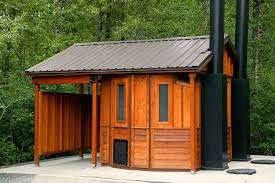Vault restrooms, also known as composting toilets, represent an innovative and eco-friendly solution to traditional sanitation challenges. These sustainable facilities have gained popularity in various settings, from remote campsites to environmentally conscious urban developments. This article delves into the concept of vault restrooms, their unique design, environmental benefits, and the growing interest in adopting them for a more sustainable future.
Understanding Vault Restrooms:
Vault restrooms differ significantly from conventional flush toilets. Instead of relying on water to transport waste to a centralized sewage system, vault restrooms utilize a simple yet effective system that combines organic matter with human waste. This process promotes decomposition and turns waste into valuable compost, contributing to a closed-loop and sustainable sanitation solution.
Design and Components:
The design of vault restrooms is tailored to facilitate the decomposition of waste and ensure minimal environmental impact. Typically, these restrooms consist of a concrete or fiberglass vault beneath the toilet seat, where the waste accumulates. The vault is equipped with ventilation systems that help control odors and accelerate the decomposition process.
To aid in decomposition, a bulking material such as sawdust, coconut coir, or peat moss is added after each use. This material provides the necessary carbon balance to promote efficient composting, transforming human waste into a nutrient-rich fertilizer. Some advanced models even incorporate automatic mixing systems to enhance the composting process.
Environmental Benefits:
Vault restrooms offer a range of environmental benefits, making them a sustainable alternative to traditional sanitation systems:
- Water Conservation: Unlike flush toilets that consume large quantities of water with each use, vault restroom are waterless or use minimal amounts for handwashing. This helps conserve water resources, particularly in regions facing water scarcity.
- Waste Reduction: The composting process significantly reduces the volume of waste generated. This not only minimizes the need for landfill space but also mitigates the environmental impact of untreated sewage.
- Nutrient Recycling: The resulting compost from the vault restroom is rich in nutrients, making it a valuable resource for soil enrichment. This nutrient recycling aspect aligns with the principles of circular economy and sustainable waste management.
- Off-Grid Capabilities: Vault restrooms are well-suited for off-grid locations where traditional sewage infrastructure is unavailable. They provide a practical solution for remote campsites, national parks, and sustainable communities aiming to minimize their ecological footprint.
Growing Popularity and Adoption:
As awareness of environmental issues continues to grow, so does the popularity of vault restroom. Many eco-conscious individuals, businesses, and municipalities are recognizing the potential of these facilities to contribute to a more sustainable future. Campgrounds, parks, and nature reserves are increasingly incorporating vault restrooms to promote responsible and environmentally friendly recreation.
Challenges and Considerations:
While vault restroom offer numerous benefits, there are challenges and considerations to address. Proper maintenance, education on usage, and regulatory compliance are crucial for ensuring the success and acceptance of these facilities. Additionally, overcoming social stigmas associated with alternative sanitation methods is essential to encourage widespread adoption.
Conclusion:
Vault restrooms represent a pioneering approach to sustainable sanitation, offering a practical solution for a variety of settings. Their innovative design, environmental benefits, and adaptability make them a promising alternative to traditional flush toilets. As society continues to prioritize sustainability, the adoption of vault restroom is likely to increase, contributing to a healthier planet and a more responsible approach to waste management.

